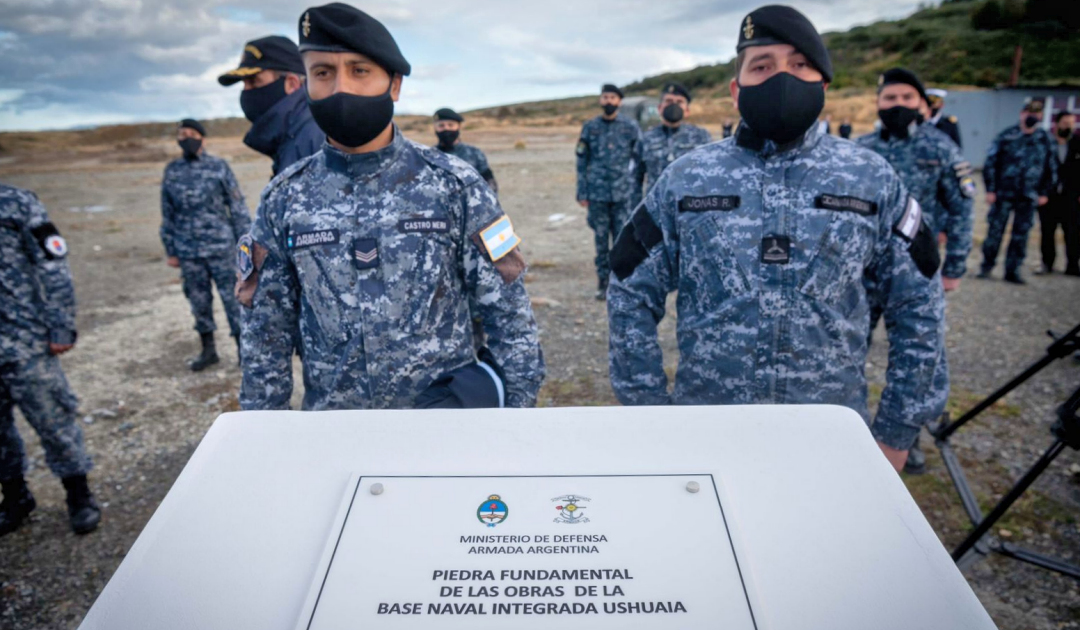
In recent years, some Antarctic Treaty parties have pushed ahead strongly with their structural programs, either redesigning or renovating stations, building new vessels and expanding their logistics points. Argentina is also making great strides in its plans for Antarctica. Two milestones have been reached within a few weeks.
To begin with, a few days ago Argentine shipyard Tandanor announced that it had signed a contract with Finnish shipbuilding company Aker Arctic for the construction of a new polar vessel to reinforce the only Argentine icebreaker, the Almirante Irizar. Furthermore, the foundation stone for the new naval base / logistics hub was officially laid in Ushuaia on March 3 by Defense Minister Jorge Taiana. Both projects are funded by the Argentine government and are intended to improve supplies to the thirteen Argentine stations in Antarctica while underscoring Argentina’s claim as one of the leading Antarctic nations in the region.

Argentina began planning to build a new ship for Antarctica in 2014. But the economic crisis and a change of government delayed the project. That is why Argentina had modernized and upgraded its icebreaker. But now the government has allocated the equivalent of about €6 million ($6.5 million) to build the ship together with the Finnish company Aker Arctic. The contract now states that the ship will be built at the Tandanor shipyard and that Aker Arctic will develop the basic engineering with Tandanor. At the signing, which was held as an online event due to the Covid pandemic, Tandanor CEO Miguel Tudino said: “The Finnish consulting firm is responsible for the design of about 85% of all polar ships. That’s why we agreed with them that we will jointly develop the basic engineering, and at Tandanor we will tackle the electrical and electronic work of the project.” Finnish Ambassador to Argentina Kirsi Vanamo-Santacruz, who was present at the signing ceremony, said: “We are very happy that Tandanor and Argentina have chosen Finnish company Aker Arctic. It’s a concrete symbol of strengthening relations between the two countries.” Tandanor has estimated a total of more than seven years for the development and construction of the vessel — about 29 months for development and five years for construction.

Shortly afterwards, the foundation stone for the new naval and logistics facility was laid in Ushuaia, the southernmost city in the world, in the presence of Taiana, local officials and military personnel. Taiana explained that the new center and base will strengthen the national presence in Tierra del Fuego and expand Argentina’s development and logistics capabilities in Antarctica and the South Atlantic. “We need to strengthen access to Antarctica and provide better opportunities. For this reason, among other improvements, we are working to restore the Petrel Station, which will become Argentina’s seventh permanent base on the white continent,” he said. Tandanor will also be involved in the construction of the base because the project is to be completed in several steps. First, two floating industrial buildings will be installed, which will be responsible for infrastructure development. After that, the docks and administration buildings are to be built. Then the quarters for service and military personnel. The mammoth project currently is projected to cost more than €270 million and will include a hangar for Hercules C-130 transport aircraft and fuel storage facilities, in addition to the port.

The expansion of the base in Ushuaia, the modernization and upgrade of the icebreaker and the construction of the new polar ship are part of President Alberto Fernandez’s order to the Ministry of Defense to develop a new strategy for the area in the South Atlantic and Antarctica. And both Taiana and Tierra del Fuego Governor Gustavo Melella referred to Argentina’s defense readiness during their speeches, while also mentioning the perennial issue of Falklands / Malvinas. In doing so, they joined in the intensified rhetoric that has been coming out of Buenos Aires in recent months about the status of the island group. However, both also emphasized the importance of the new center for Ushuaia as the gateway to Antarctica. “We have reached a consensus with the federal government that we will work with the municipality of Ushuaia and the private sector so that this site is not owned or managed by the military, otherwise no foreigners will come and leave their equipment and belongings on a military site,” Melella told the press.
Dr Michael Wenger, PolarJournal
More on the subject:





